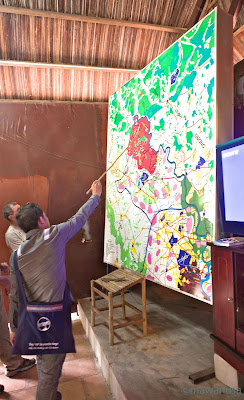About the image above: natural jungle of Cu Chi area where the tunnels are ends! With camouflaged by the dried leaves, you will have difficulties to recognize neither landmines nor other traps.
About the image above: precise introduction and explanation given to every visitors just before enter the site.
The tunnels are look not really suitable to live in but during the war it was the best hiding spot for the guerillas. From the video shown to us before entering the area, I could imagined that this was a brilliant construction with many accesses and used to communicate among the guerrillas, as routes, to store food, hospitals and of course to store their weaponry and accommodated for mostly the fighters.
About the image above: the round tunnel probably this is not a exact tunnel but is good to see and to be part of the tour.
About the image above: one of the tunnels amongst hundreds of them. A strong rims built around to protect the water overflowing to the inside tunnels.
Now tourist can enjoy and visit to this site since the Vietnamese government open it for public with some additional of facilities that make this place more look interesting and memorable. Few dioramas of activities during the war are also displays here. You can see on how the soldiers produce their own weapon, make traps, landmines, clothes, rubber slippers and what kind of food they eat during the war.
About the image above: a visitor experiences the tunnel, the purpose of this artificial tunnel is only attraction for tourist to take pictures. Few other visitors gather around to queue to try this unique site.
About the image above: another visitor experience the wider tunnel. She tried to crawl down carefully because some of the site maybe slippery.
The tour will start from the entrance that you will need to buy entrance tickets for few sites. And then you pass the ticket for verification and allow you to enter the site. Start with the video about the war and how the tunnel created and discovered. After the video show, you will be asked if you are part of a group or if you are not; a guide will accompany you and show you around and explained the details of the area. From the entrance tunnel, the traps, the ventilation, etc. The guide will accompany you until the end of the tour.
About the image above: a visitor experienced to shoot with real bullet using an old gun.
The most sites we like are the shooting range and the making of rice paper. You can by some of the real bullets to shoot using the M16, AK47 and I tried both of them. I never shoot with the real bullets since this time. I was bit not confidence when I did the shoot for the first bullet. The second until the last bullets all were fine and I really enjoyed it. The sound of both the guns produced very loud sound, I cannot imagine how were the soldiers in the battlefield can surviving with this psychological pressure with many bullet fired, bombs dropped everywhere.
About the image above: some weapons that produce in this site were on display under this small hut.
About the image above: the end of the tunnels protected by grass hut to make sure the rainwater will not go to the lower tunnels
The other site we are really like the Vietnamese girl making the rice paper. Look very simple but we think this a bit difficult for me since we never do this. One by one she prepared the transparent round wrapper and sundried in front of the house.
After this site we also tried to experience with tunnel. We went inside of the tunnel. It was not comfortable time for me, we realized that we cannot breathe so easily during crawled to the inside of the tunnels but we managed to escape out from this tiny hole after almost 12 minutes. It was fun too!
About the image above: a robotic smith soldier demonstrated on how to keep fire on during the making of the traditional weaponry.
About the image above: a soldier on duty to prepare slippers for the guerillas.
Leaving this hut house of the tunnel, we reached the house where afternoon tea and snack served by few girls in black uniform. It was nicely brewed tea and steamed cassava with some salt. Taste very nice and refreshing. We glad that we can visit this place and experienced this unique site. How about you?



























